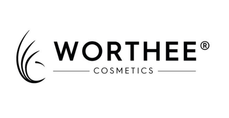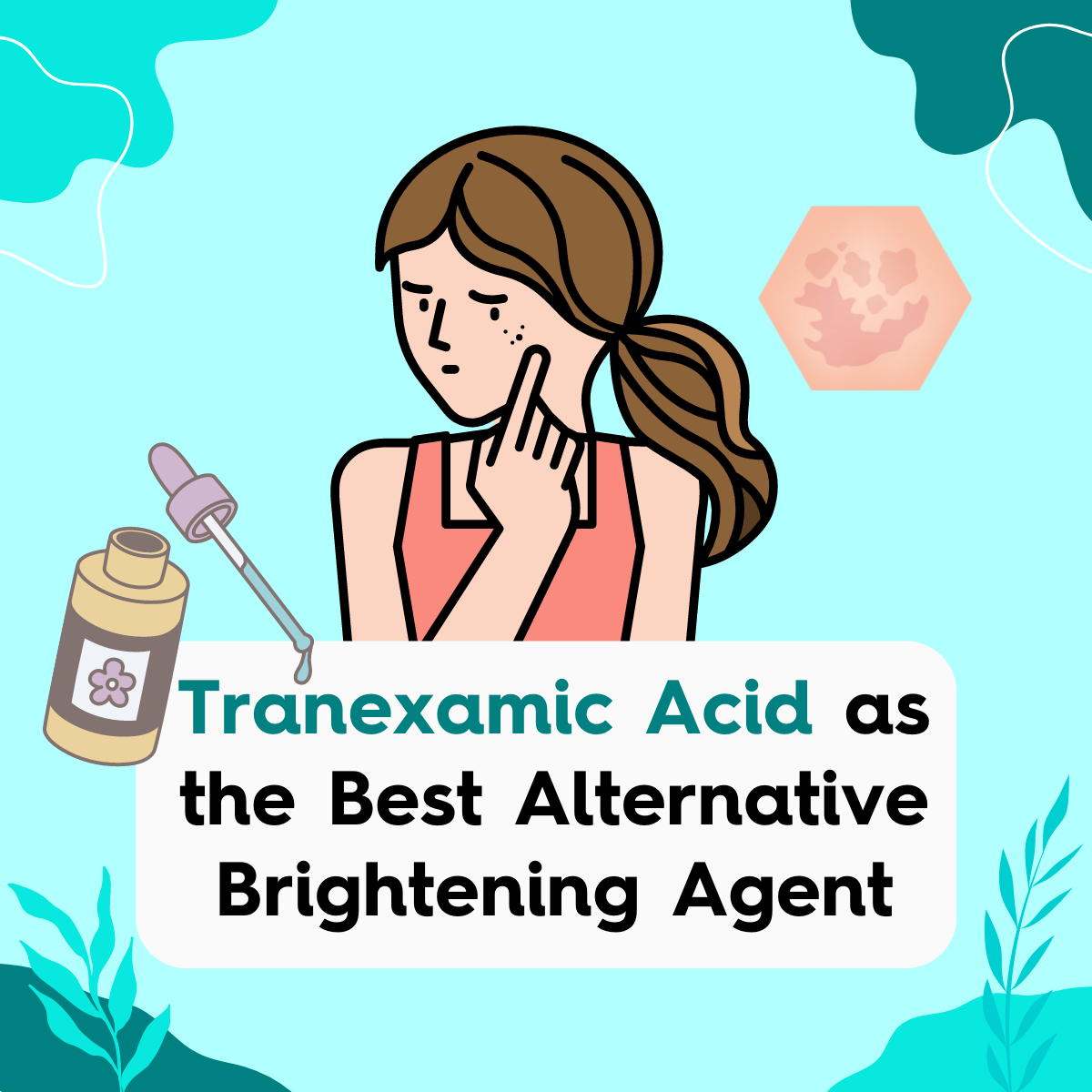With so many great brighteners in the beauty world, where does Tranexamic Acid (or TXA) stand?
We dived into the research papers about TXA with this problem statement in mind. A couple of studies compared TXA with brightening superstars like L-Ascorbic Acid, Azelaic Acid and Hydroquinone. We presented the summary below for you,
Have we found THE BEST brightening ingredient? Nah, melanin (darkening pigment) formation is complicated. TXA happens to be one of the truly great brighteners that helps erase the appearance of stubborn skin pigmentation. The best approach would still be incorporating more than one brightening agent in your skincare routine, to increase the chances of interrupting the multiple pathways of melanin biosynthesis.
Of course, sunscreen every day!
What is Tranexamic Acid?

TXA is a synthetic form of α-amino acid lysine (protein’s building block).
TXA works as a tyrosinase (the main enzyme functioning in the production of darkening pigment) inhibitor, hence it is actively used for hyperpigmentation treatment in three ways:
- Oral
- Injection (intradermal)
- Topical
The History of Tranexamic Acid
In the sphere of dermatology, TXA is surely an interesting brightening ingredient. However, on the other side of the medical world, it is a life-saving ingredient that has revived countless women’s lives from uncontrollable blood loss, especially during childbirth.
TXA was discovered by a couple of Japanese researchers, Dr Shosuke and Utako Okamoto, during World War II in 1962 in Japan. Their actual desire was to reduce the death rate from extreme loss of blood. TXA was surprisingly found to be effective in limiting blood loss.
Fast forward to decades later, in 1979, Nijo Sadako was using TXA to treat a patient with itchy rashes spread all over the face, and brown spots at the same time. It was an accidental outcome that, within 2-3 weeks, a significant reduction of the pigmented areas was observed, leading to further discoveries of using TXA orally to treat melasma.
Benefits of Tranexamic Acid in Skincare
There seems to be more evidence supporting the performance of TXA in lightening discoloration orally, than topically.
For the topical application of TXA, studies show that concentrations between 2% and 5% would fade facial pigmentation (mostly melasma) significantly, with less risk of irritation as compared to the gold-standard lightener - Hydroquinone. TXA mainly inhibits tyrosinase activity by preventing plasminogen’s conversion to plasmin.
Tranexamic Acid vs. Other Brightening Agents
TXA vs. Vitamin C
In 2019, 30 subjects with melasma were given 5% TXA on the left side of the face and 20% of Vitamin C on the right side of the face. The researchers found that at week 4, the percentage of improvement for TXA was 8.9%, while Vitamin C was 3.7%. At week 8, the percentage of improvement for TXA rose to 20.5% while Vitamin C was 12.3%.
 TXA vs. Azelaic Acid
TXA vs. Azelaic Acid
100 subjects were randomly and evenly divided into two groups. Group A applied topical 3% TXA Solution + oral 250 mg TXA while Group B applied topical 20% Azelaic Acid + oral 250 mg TXA.
Over 6 months, the mean Melasma Area and Severity Index (MASI) score was significantly lesser in the 3% TXA group than in the 20% Azelaic Acid group.
 TXA vs. Hydroquinone
TXA vs. Hydroquinone
A 2015 study consisting of 60 women discovered that topical application of 5% TXA was on par with 2% Hydroquinone in the treatment of melasma, for twice daily, 12 weeks.

TXA vs. Hydroquinone + Retinoid
In another study with 205 subjects, for 6 months, it was found that 2% Hydroquinone + Tretinoin performed slightly better than 3% TXA in the treatment of melasma.

Tranexamic Acid Product Suggestions
Following the advised standard of concentration of TXA around 2% and 5%, here are some of the products that you can consider topping up in your routine if you have pigmentation concerns.
It is worthwhile to note that in Malaysia, or those countries following the ASEAN cosmetic regulatory standards, TXA use in skin care products should not exceed more than 3% in regulation.
Bffect Luz Brightening Essence with 2% TXA blends three high-performing brighteners to interrupt the melanin synthesis pathways. Specifically, TXA and Potassium Methoxysalicylate inhibit the viability of tyrosinase to curb melanocyte cell production. Meanwhile, α-MSH is the peptide hormone secreted into the bloodstream to stimulate tyrosinase activity, generating darkening pigments. Nonapeptide-1 can compete against α-MSH on its receptor (MC1-R) to stop any progress of tyrosinase activation, blocking melanin synthesis, ultimately allowing control for skin brightness and preventing future development of discolourations. Hence, you can expect this product to moderate uneven skin tone, dark spots and discolouration. Your skin will appear glowing, dewy and supple with consistent usage.

Minimalist Tranexamic 3% + HPA is a powerful serum to effectively diminishes the appearance of Melasma, PIE, PIH and hyperpigmentation. With the power of 3% TXA and 1% Hydroxyphenoxy Propionic Acid, which inhibits melanin transfer with great efficacy and prevents UVB damage. The formula further contains 3% Mandelic Acid which gently exfoliates and further reduces post-inflammatory hyperpigmentation like post-acne marks. It is perfect for anyone who is looking for a safe, and yet, effective skin lightener.

The Precautions before Using Topical TXA
TXA increases the risk of developing blood clots. Though the actual absorption of TXA into the bloodstream via topical skincare is unknown, we encourage you to consult your physician before use especially if you have blood disorders, and vascular or heart diseases.
References
- Atefi, N., Dalvand, B., Ghassemi, M., Mehran, G., & Heydarian, A. (2017). Therapeutic effects of topical TXA in comparison with hydroquinone in the treatment of women with Melasma. Dermatology and Therapy, 7(3), 417–424. https://doi.org/10.1007/s13555-017-0195-0
- London School of Hygiene & Tropical Medicine. (n.d.). TXA: History. TXA Central. Retrieved October 3, 2022, from https://txacentral.lshtm.ac.uk/history/
- Forbat, E., Al‐Niaimi, F., & Ali, F. R. (2019). The emerging importance of TXA in dermatology. Clinical and Experimental Dermatology, 45(4), 445–449. https://doi.org/10.1111/ced.14115
- Malik, F., Hanif, M. M., & Mustafa, G. (2019). Combination of Oral TXA with Topical 3% TXA versus Oral TXA with Topical 20% Azelaic Acid in the Treatment of Melasma. Journal of the College of Physicians and Surgeons--Pakistan : JCPSP, 29(6), 502–504. https://doi.org/10.29271/jcpsp.2019.06.502
- Menon, A., Eram, H., Kamath, P. R., Goel, S., & Babu, A. M. (2019). A Split Face Comparative Study of Safety and Efficacy of Microneedling with TXA versus Microneedling with Vitamin C in the Treatment of Melasma. Indian dermatology online journal, 11(1), 41–45. https://doi.org/10.4103/idoj.IDOJ_22_19
- Sharma, Y. K., & Gupta, A. (2016). Some Other Serendipitous Discoveries in Dermatology. Indian journal of dermatology, 61(1), 95–96. https://doi.org/10.4103/0019-5154.174045


